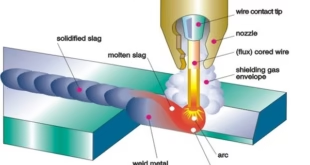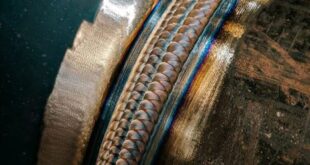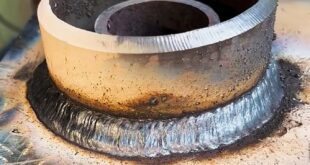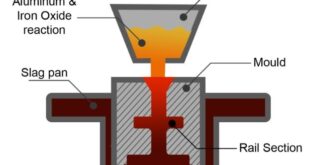Carbon Arc Welding
Introduction to Carbon Arc Welding
Carbon Arc Welding is welding process is a type of arc welding process that uses a carbon electrode to produce an electric arc between the electrode and the metal workpiece. The heat generated by the arc melts the metal and creates a weld. This process was first developed in the late 19th century and has been used in various industries such as shipbuilding, construction, and heavy machinery manufacturing.
The purpose of Carbon Arc Welding is to join two metal pieces by heating them to their melting points and fusing them together. It is particularly useful for welding heavy and thick metal plates, as well as for welding metals that are difficult to weld using other processes. Carbon Arc Welding is also used for cutting metal and for surfacing, where a layer of metal is added to a workpiece to improve its surface properties. Despite its usefulness, it is becoming less common as other welding processes, such as gas metal arc welding and flux-cored arc welding, have become more popular.
Welding Process of Carbon Arc Welding
- Equipment and materials Carbon Arc Welding require a power source, such as a welding generator or rectifier, an electrode holder, a welding cable, carbon electrodes, and protective gear for the welder, such as a helmet, gloves, and protective clothing.
- Preparation Before starting the welding process, the workpiece must be cleaned of any surface contaminants such as rust, grease, or paint. The electrode holder and the workpiece should also be securely clamped in place to prevent movement during welding.
- Procedure The welder strikes an arc between the electrode and the workpiece by touching the electrode to the workpiece and then pulling it away. The electric arc produces heat that melts the metal, creating a weld pool. The welder must then manipulate the electrode and the workpiece to produce a consistent weld.
- Safety measures Carbon Arc Welding produces intense light and heat, as well as dangerous fumes and spatter. The welder must wear proper protective gear to prevent eye damage, burns, and inhaling hazardous fumes. The welding area should also be well-ventilated to prevent accumulation of fumes. Additionally, the workpiece and surrounding area should be protected from sparks to prevent fires.
Advantages and Disadvantages
Advantages:
- Carbon Arc Welding produces strong and durable welds that can withstand high stress and harsh conditions.
- The process is well suited for welding thick metal plates, making it ideal for heavy industries such as shipbuilding and construction.
- Carbon Arc Welding can be used to weld metals that are difficult to weld using other processes, such as cast iron and high-carbon steels.
- Carbon Arc Welding can be used for surfacing, where a layer of metal is added to a workpiece to improve its surface properties.
Disadvantages:
- The process generates high heat, which can cause warping, cracking, or distortion of the workpiece.
- Carbon Arc Welding produces harmful fumes and spatter that can be hazardous to the welder and the surrounding environment.
- Carbon Arc Welding requires a skilled operator to produce a consistent and high-quality weld.
- With the advent of other welding processes, such as gas metal arc welding and flux-cored arc welding, Carbon Arc Welding is becoming less common.
- Carbon Arc Welding requires specialized equipment and materials, making it more expensive than other welding processes.
Applications
Applications of Carbon Arc Welding include:
Shipbuilding:
Carbon Arc Welding is used in the shipbuilding industry for welding the hulls of ships and other large metal structures.
Construction:
The process is used in the construction industry for welding heavy metal structures such as bridges and building frameworks.
Heavy machinery manufacturing:
Carbon Arc Welding is used in the manufacture of heavy machinery such as bulldozers, excavators, and cranes.
Repair and maintenance:
The process is used for repair and maintenance of heavy equipment and machinery.
Metal fabrication:
Carbon Arc Welding is used in metal fabrication for welding and cutting metal components.
FAQs
What are the limitations of carbon arc welding?
Limitations of carbon arc welding: It requires a high level of operator skill, generates intense heat and UV radiation, produces excessive slag, and produces fumes and sparks.
What is carbon arc welding suitable particularly for?
Carbon arc welding is suitable for welding non-ferrous metals such as aluminum, magnesium, and copper alloys.
Why is carbon used in carbon arc welding?
Carbon is used in carbon arc welding as the electrode material because it conducts electricity and can withstand high temperatures.
What polarity is used for carbon arc?
Direct current (DC) electrode negative (DCEN) polarity is used in carbon arc welding.
Which electrode is used in carbon arc welding?
Graphite or carbon electrodes are used in carbon arc welding.
What is the temperature of carbon arc welding?
The temperature of carbon arc welding can reach up to 6,300°F (3,500°C).
Why does carbon decrease weldability?
Carbon decreases weldability because it contaminates the weld pool and can result in porosity and poor joint quality.
Why is carbon a preferred electrode?
Carbon is a preferred electrode because it is readily available and relatively low cost.
What are the different types of carbon arc welding?
Different types of carbon arc welding include manual carbon arc welding, automatic carbon arc welding, and carbon arc gouging.
How old is carbon arc welding?
Carbon arc welding has been in use since the late 19th century.
Can you cold weld carbon?
No, carbon cannot be cold welded.
Are carbon rods flammable?
Carbon rods are not flammable, but the intense heat generated during carbon arc welding can ignite nearby flammable materials.
Conclusion
In conclusion, Carbon Arc Welding is a welding process that uses a carbon electrode to produce an electric arc between the electrode and the metal workpiece. The process was first developed in the late 19th century and has been used in various industries such as shipbuilding, construction, and heavy machinery manufacturing. Carbon Arc Welding is well-suited for welding thick metal plates and for welding metals that are difficult to weld using other processes. The process is becoming less common as other welding processes, such as gas metal arc welding and flux-cored arc welding, have become more popular. Carbon Arc Welding requires specialized equipment and materials, and it is more expensive than other welding processes. The process generates high heat and dangerous fumes, and it requires a skilled operator to produce a consistent and high-quality weld. Despite its disadvantages, Carbon Arc Welding remains a valuable welding process for industries that require strong and durable welds.
 Welding of Welders All about Welding and Welders
Welding of Welders All about Welding and Welders



